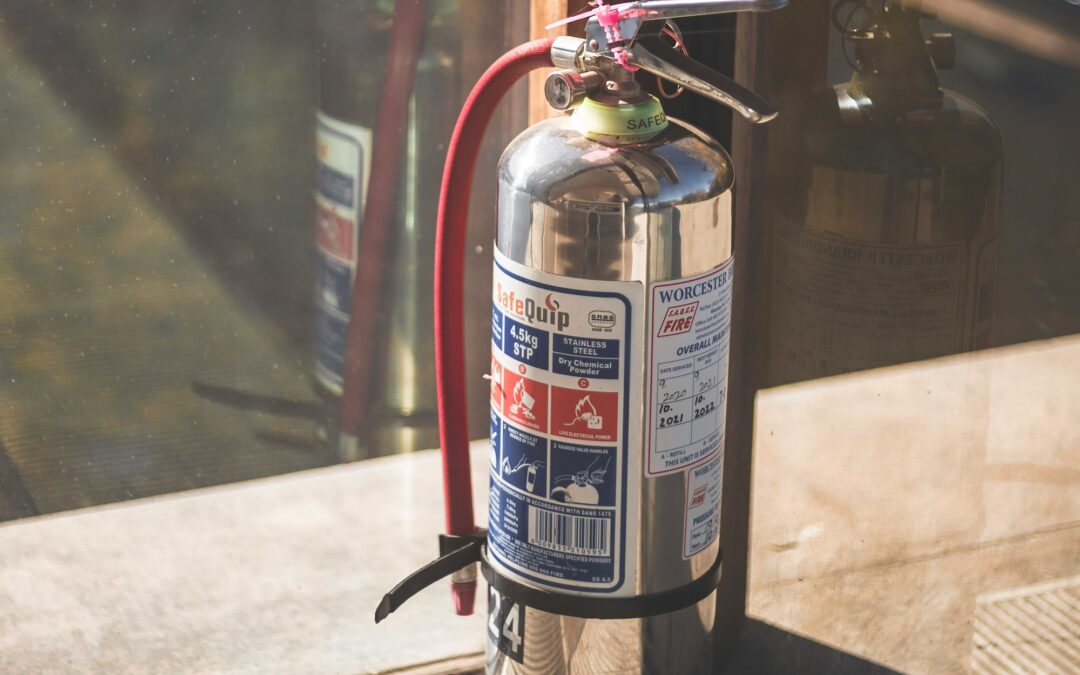Replace or service an extinguisher right away if it’s been used (to any degree) or if
you notice any of the following:
- The hose or nozzle is cracked, ripped, or blocked with debris.
- The metal locking pin on the handle is missing or if the safety seal is missing/not intact.
- The handle is wobbly or broken.
Monthly Inspection
These inspections can be done by the owner.
- Confirm the extinguisher is visible, unobstructed, and in its designated location.
- Verify the locking pin is intact and the tamper seal is unbroken. Examine the extinguisher
- for obvious physical damage, corrosion, leakage, or a clogged nozzle.
- Check for a full charge. If the pressure gauge reads within the “green” zone, or the pin
- indicator pops back up when pushed, the extinguisher is properly pressurized.
- Lift the extinguisher to ensure it is still full.
- Assure the operating instructions on the nameplate are legible and facing outward.
- Check the last professional service date on the tag.
- Keep a record of inspection dates.
Ongoing Maintenance
Always follow manufacturer maintenance guidelines. Each fire extinguisher should have a tag or label securely attached that indicates that maintenance was performed. Extinguishers also need a verification-of-service collar located around the neck of the canister if an internal examination was done.
Non-rechargeable (aka “disposable”) fire extinguishers
These have a plastic valve, and the pressure gauge reads from “Full” to “Empty.”
- Invert the extinguisher several times once/month to avoid having the
- extinguishing agent “cake” at the bottom of the canister.
- Replace 10 years after the original fill date, or, unavailable, the manufacture date
- (located on the UL nameplate/label on the extinguisher canister or on the canister
- bottom). Some manufacturers state 12 years until replacement.
Rechargeable extinguishers
These have a metal valve, and the pressure gauge reads from “Undercharged” to “Overcharged.” The life of the extinguisher and maintenance intervals are based on the original fill date, not the date of manufacture. If the original fill date is unknown, go by the manufacture date.
Dry chemical rechargeable extinguishers
These are primarily Class ABC (usually mono- or di-ammonium phosphate) and dry
Class BC (usually sodium bicarbonate) extinguishers.
- Invert the extinguisher several times once/month to avoid having the
- extinguishing agent “cake” at the bottom of the canister.
- The extinguisher must be professionally inspected (includes an internal
- inspection) and recharged once every 6 years—even if unused.
- Hydrostatically test professionally (to verify strength against rupture) once every 12 years.
- Maintenance needs to be performed by a certified person.
Water (Class A) and water mist (Class BC) extinguishers
These extinguishers can be refilled by the owner. Fill the canister to the
manufacturer’s specified volume. Discharge, disassemble, and inspect annually (NFPA 10, 4-4.1. 1); hydrostatically test professionally once every 5 years.
For water extinguishers:
- Refill using regular water.
- Pressurize with air, but nitrogen is ideal. For air, one can do this using a small
- compressor or a high pressure bicycle pump.
For water mist extinguishers:
- Refill using either deionized or distilled water.
- (Regular water cannot be used for extinguishing Class C fires.)
- Ideally pressurize with nitrogen rather than air. Pressurizing usually requires a special
- adapter fitting (including all Amerex models). There are fire supply companies in Sonoma
- County that will pressurize these extinguishers with nitrogen for free.
- There is no mandatory “expiration date” for rechargeable fire extinguishers in the United
- States. The lifespan depends on a number of factors. Per Kaufman Co., “If you keep up
- with maintenance and hydrostatic testing requirements, you can expect your
- extinguishers to last for many decades.”
- The above only pertains to the most popular and/or practical fire extinguisher types
- used by homeowners. Other types, like C0 2 extinguishers, potassium bicarbonate
- (aka “Purple K”) extinguishers, chemical foam, and Class D extinguishers, may
- require different maintenance and/or schedules.
Sources
- NFPA Today: “Guide to Fire Extinguisher Inspection, Testing, and Maintenance,”
- 10/30/2020, by Brian O’ Connor, Technical Services Engineer.
- California Fire Protection and Backflow: California Code of Regulations on Fire Extinguishers
- Koorsen Fire and Security website
- NFPA 10 Standard for Portable Fire Extinguishers
- Guardian Fire Protection website
- First Alert website
- State Compensation Insurance Fund: Safe at work California. Fire Extinguishers 2/12/2021
- UC San Diego Blink website
- Kauffman Company, Houston TX
Compiled by Carl J. Wahl, Jr.

